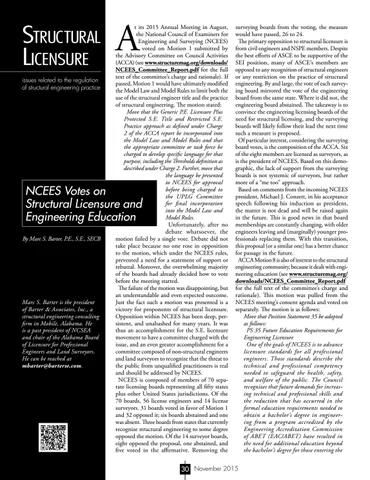Structural licenSure issues related to the regulation of structural engineering practice
A
t its 2015 Annual Meeting in August, the National Council of Examiners for Engineering and Surveying (NCEES) voted on Motion 1 submitted by the Advisory Committee on Council Activities (ACCA) (see www.structuremag.org/downloads/ NCEES_Committee_Report.pdf for the full text of the committee’s charge and rationale). If passed, Motion 1 would have ultimately modified the Model Law and Model Rules to limit both the use of the structural engineer title and the practice of structural engineering. The motion stated: Move that the Generic P.E. Licensure Plus Protected S.E. Title and Restricted S.E. Practice approach as defined under Charge 2 of the ACCA report be incorporated into the Model Law and Model Rules and that the appropriate committee or task force be charged to develop specific language for that purpose, including the Thresholds definition as described under Charge 2. Further, move that the language be presented to NCEES for approval before being charged to the UPLG Committee for final incorporation into the Model Law and Model Rules. Unfortunately, after no debate whatsoever, the motion failed by a single vote. Debate did not take place because no one rose in opposition to the motion, which under the NCEES rules, prevented a need for a statement of support or rebuttal. Moreover, the overwhelming majority of the boards had already decided how to vote before the meeting started. The failure of the motion was disappointing, but an understandable and even expected outcome. Just the fact such a motion was presented is a victory for proponents of structural licensure. Opposition within NCEES has been deep, persistent, and unabashed for many years. It was thus an accomplishment for the S.E. licensure movement to have a committee charged with the issue, and an even greater accomplishment for a committee composed of non-structural engineers and land surveyors to recognize that the threat to the public from unqualified practitioners is real and should be addressed by NCEES. NCEES is composed of members of 70 separate licensing boards representing all fifty states plus other United States jurisdictions. Of the 70 boards, 56 license engineers and 14 license surveyors. 31 boards voted in favor of Motion 1 and 32 opposed it; six boards abstained and one was absent. Three boards from states that currently recognize structural engineering to some degree opposed the motion. Of the 14 surveyor boards, eight opposed the proposal, one abstained, and five voted in the affirmative. Removing the
NCEES Votes on Structural Licensure and Engineering Education By Marc S. Barter, P.E., S.E., SECB
Marc S. Barter is the president of Barter & Associates, Inc., a structural engineering consulting firm in Mobile, Alabama. He is a past president of NCSEA and chair of the Alabama Board of Licensure for Professional Engineers and Land Surveyors. He can be reached at mbarter@barterse.com.
surveying boards from the voting, the measure would have passed, 26 to 24. The primary opposition to structural licensure is from civil engineers and NSPE members. Despite the best efforts of ASCE to be supportive of the SEI position, many of ASCE’s members are opposed to any recognition of structural engineers or any restriction on the practice of structural engineering. By and large, the vote of each surveying board mirrored the vote of the engineering board from the same state. Where it did not, the engineering board abstained. The takeaway is to convince the engineering licensing boards of the need for structural licensing, and the surveying boards will likely follow their lead the next time such a measure is proposed. Of particular interest, considering the surveying board votes, is the composition of the ACCA. Six of the eight members are licensed as surveyors, as is the president of NCEES. Based on this demographic, the lack of support from the surveying boards is not systemic of surveyors, but rather more of a “me too” approach. Based on comments from the incoming NCEES president, Michael J. Conzett, in his acceptance speech following his induction as president, the matter is not dead and will be raised again in the future. This is good news in that board memberships are constantly changing, with older engineers leaving and (marginally) younger professionals replacing them. With this transition, this proposal (or a similar one) has a better chance for passage in the future. ACCA Motion 8 is also of interest to the structural engineering community, because it dealt with engineering education (see www.structuremag.org/ downloads/NCEES_Committee_Report.pdf for the full text of the committee’s charge and rationale). This motion was pulled from the NCEES meeting’s consent agenda and voted on separately. The motion is as follows: Move that Position Statement 35 be adopted as follows: PS 35 Future Education Requirements for Engineering Licensure One of the goals of NCEES is to advance licensure standards for all professional engineers. Those standards describe the technical and professional competency needed to safeguard the health, safety, and welfare of the public. The Council recognizes that future demands for increasing technical and professional skills and the reduction that has occurred in the formal education requirements needed to obtain a bachelor’s degree in engineering from a program accredited by the Engineering Accreditation Commission of ABET (EAC/ABET) have resulted in the need for additional education beyond the bachelor’s degree for those entering the
30 November 2015








